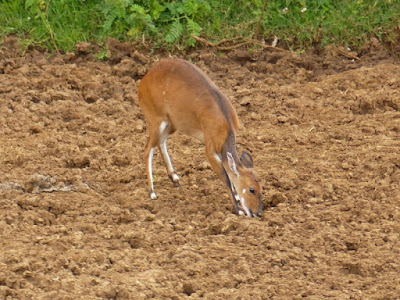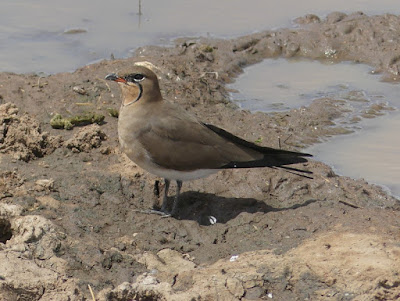Yes, I know I've pinched that title from Flanders and Swan, but I promise not to mention hippopotamuses. I've pondered this post for some years, since watching swarms of parrots coming to the wonderful Blanquillo clay lick on the banks of the Madre de Dios River in the southern Peruvian Amazonia. It was an astonishing experience, travelling before dawn by river and on foot through the forest to settle into the most commodious hide I've ever been in, and seeing the birds come in waves to eat clay from the high river banks.
 |
| Red and Green Macaws Ara chloropterus gathering on the Blanquillo wall. (And yes, I know they've got more blue than green, but I didn't name them.) |
 |
| Here we can clearly see the huge macaws chewing on the clay. Some of these birds may have travelled up to 100km for this moment. |
 |
| A small section of the sumptuous hide, which extends well to the left of this photo. The clay banks are visible below the hide. |
 |
| Blue-headed Parrots Pionus menstruus and Orange-cheeked Parrots Pyrilia barrabandi. The names enable ready identification in the photo. |
So, spectacular indeed, but why do they, and many other animals, do it? It's called geophagy, and it's a topic that's occupied many good scientists (and that's not including the surprisingly large field of human geophagy, which is well beyond the remit of this blog). To cut right to the point, it seems clear that there is no one reason for the practice, and given that it's undertaken by animals as varied as primates, antelopes, tapirs and butterflies, as well as parrots and pigeons, that's hardly surprising. Chimpanzees suffering from diarrhoea were observed to eat soils containing minerals similar to those sometimes prescribed to humans with the same ailment, but this is surely not relevant to the parrots.
It comes down to two main lines of argument, each of which often claims to be the 'right' one. One involves the selective ingestion of essential dietary minerals, and there seems little doubt that this is the basis of much dirt-eating. Termite mound soil is particularly attractive to animals from elephants and giraffes to parrots and it has been shown that the mound contains far higher levels of organic material, as well as phosphorus and potassium, than the surrounding soil. Parrots visiting sites like Blanquillo choose clays that have high sodium levels relative to surrounding soils, and much higher than their fruit diet; sodium is rapidly leached out of rainforest systems far from the sea. This need seems to peak during breeding season, when birds are stressed. However in rainforest near the sea in Central America sodium is apparently more readily available and birds seemingly don't visit clay sources.
Butterflies widely indulge in sucking nutrients from clay - indeed there's a term for it, 'mud-puddling'. With the same proboscis that they use for extracting nectar from flowers, they suck liquid from wet soil, extract sodium in particular, and excrete lots of water. Here are a few, from both Africa and South America; sadly I can't offer you names for many of them - any assistance gratefully received!
 |
| An astonishing collection, including many of family Pieridae, from along the Manu River in Peruvian Amazonia. |
The Manu River banks in fact supplied probably the most dramatic butterfly watching I've enjoyed; here are some more.
 |
| Prola Beauties Panacea prola, top and bottom views. |
 |
| King Swallowtail Heraclides thoas. |
Iguazu Falls, especially on the Argentinian side, was pretty good for mud-puddling butterflies too.
 |
| Broad-banded Swallowtails Heraclides astyalus (top two and nearest the camera) and others. |
 |
| Common Small Lemon Eurema deva, also at Iguazu. |
 |
| More massed Pierids, including Small Lemons, Iguazu. |
 |
| And lastly from Iguazu, this lovely Ruby-spotted Swallowtail Heraclides anchisiades. |
Ecuador is always fabulous; here are a couple of puddlers from Yasuní National Park.
 |
| Urania Moth, Urania sp. (And the white outline looks like a bad bit of editing, but I promise I've done nothing to the image!) |
And an African offering, from the wonderful Budongo Forest in Uganda.
But, back in the Amazon monkeys also chew on clay - and they don't seek out high sodium sources.
 |
| Venezuelan Red Howler Monkeys Alouatta seniculus nibbling on clay, while putting their prehensile tails to good use. |
What's going on here? This leads us to the other strand of evidence for dirt-eating. These monkeys, and many other animals, select fine-grained clays, with no interest in their nutritional values. Plants in general would rather not be eaten, and many carry some nasty toxins in the leaves to protect themselves. Fruits are intended by the plants to be eaten, so the seeds may be carried away, but only when the seeds are mature enough to germinate. Before that, not only are the fruits not luscious and sweet, but are often actively poisonous to prevent animals from getting in too early. Anyone who's gardened however knows that birds will often eat fruit before we want to or even could. One way that many animals escape these toxins is to eat fine clays which chemically bind up the nasties, particularly various alkaloids, to prevent them being taken up by the body, and perhaps to protect the gut wall from corrosive chemicals. This seems to be a widespread practice by leaf and fruit eaters.
Recently, from the marvellous viewing deck at the lodge on the lower slopes of Mount Kenya, we watched two very different herbivores availing themselves of the mud as medication.
Recently, from the marvellous viewing deck at the lodge on the lower slopes of Mount Kenya, we watched two very different herbivores availing themselves of the mud as medication.
 |
| Female Bushbuck Tragelaphus sylvaticus unambiguously eating the dried mud. |
 |
| African Buffalo bulls Syncerus caffer, known colloquially as 'dagga boys', the dagga meaning mud. These were enjoying the wallow in Queen Elizabeth NP, Uganda. |
 |
| Part of a large group of African Bush Elephants Loxodonta africana enjoying the mud after drinking nearby in arid Buffalo Springs NR, northern Kenya. |
 |
| This venerable cow in Murchison Falls NP in Uganda didn't get down into the mud, but sprayed it liberally on her back. |
 |
| Galápagos Giant Tortoises Chelonoidis nigra relaxing in the mud on Santa Cruz, one of the few places in the generally arid archipelago where a wallow can be reliably found. |
 |
| Pacific Swallow Hirundo tahitica actively collecting pellets of mud to daub into a nest, Kuala Penya, Sabah, Malaysian Borneo. |
 |
| White-winged Choughs Corcorax melanorhamphos (chick's head at left), Canberra. Choughs and the related Apostlebirds are among the most strongly cooperative bird breeders in the world. |
So, I hope this introduction to some of the things you can do with mud has been of interest, even if you're not tempted to try all of them! Thanks for wallowing along with me.
NEXT POSTING THURSDAY 11 JUNE.
And remember that you can get a reminder when the next post appears by putting your email address in the Follow by Email box in the top right of this screen.
I'd love to receive your comments - it's easy and you don't need to sign in!
And remember that you can get a reminder when the next post appears by putting your email address in the Follow by Email box in the top right of this screen.
I'd love to receive your comments - it's easy and you don't need to sign in!















































